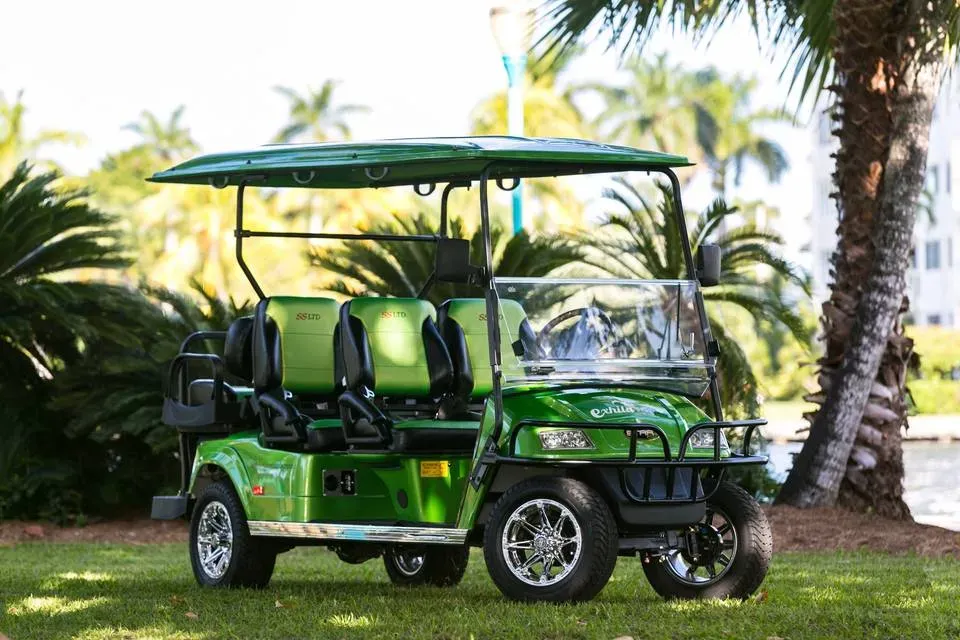Electric Golf Carts and LSVs: A Green Revolution on the Roads and Courses
Electric golf carts and Low-Speed Vehicles (LSVs) have become increasingly popular in recent years, revolutionizing the way people navigate golf courses, gated communities, resorts, and even city streets. As concerns about environmental sustainability, energy efficiency, and the cost of traditional vehicles grow, these electric alternatives are emerging as smart, eco-friendly solutions for short-distance travel. In this article, we will explore the features, benefits, and growing popularity of electric golf carts and LSVs, highlighting their role in shaping the future of personal transportation.
What are Electric Golf Carts and LSVs
Electric golf carts are small, battery-powered vehicles designed primarily for use on golf courses. Traditionally, golf carts were used to transport players and their equipment across the course, but over time, they have expanded to various recreational and utility uses. Today’s electric golf carts are equipped with powerful batteries that allow them to travel long distances without the need for fossil fuels.
Low-Speed Vehicles (LSVs), on the other hand, are street-legal electric vehicles that are similar in design to golf carts but are built for use on public roads. LSVs are typically limited to speeds of 25-35 mph, making them suitable for short trips within designated areas, such as retirement communities, gated neighborhoods, or small towns. Unlike regular golf carts, LSVs comply with federal regulations for motor vehicles and are equipped with additional features such as headlights, seat belts, and turn signals to meet road safety standards.
The Rise of Electric Golf Carts and LSV
The increasing popularity of electric golf carts and LSVs can be attributed to several factors. First and foremost, environmental concerns about carbon emissions from gasoline-powered vehicles are driving people to seek cleaner alternatives. Golf carts and LSVs offer a sustainable mode of transport, as they are fully electric and produce zero emissions, making them an attractive option for those looking to reduce their environmental footprint.
In addition to environmental benefits, electric golf carts and LSVs are also economically advantageous. These vehicles are much cheaper to maintain than their gasoline counterparts. Electric motors have fewer moving parts, reducing the need for expensive repairs and maintenance. The cost of charging an electric vehicle is also significantly lower than fueling a gasoline-powered car, making them more affordable for daily use.
Moreover, the growing trend of eco-consciousness, particularly in upscale neighborhoods and resorts, has further fueled the demand for electric golf carts and LSVs. The quiet, pollution-free nature of these vehicles makes them ideal for areas where noise and air quality are a concern.
Benefits of Electric Golf Carts and LSVs
There are numerous benefits associated with electric golf carts and LSVs, both from a personal and environmental standpoint. Here are some of the key advantages:
Environmental Sustainability
One of the biggest advantages of electric golf carts and LSVs is their environmental impact. These vehicles run on electricity, meaning they don’t rely on gasoline or diesel fuel. As a result, they produce zero emissions, helping to reduce air pollution and minimize the carbon footprint of short-distance travel. For communities and businesses focused on sustainability, switching to electric vehicles represents a significant step toward environmental responsibility.
Cost-Effectiveness
Electric vehicles are significantly cheaper to maintain than traditional gasoline-powered cars. The electric motor requires less frequent servicing, and with fewer parts that can wear out, the long-term maintenance costs are much lower. Additionally, electricity costs for charging an electric golf cart or LSV are considerably lower than the cost of gasoline, leading to reduced overall operating expenses. For golf courses, resorts, and homeowners, this can translate into substantial savings over time.
Quiet Operation
Electric golf carts and LSVs are incredibly quiet compared to their gasoline-powered counterparts. This is particularly beneficial for golf courses, retirement communities, and resorts where noise levels need to be kept to a minimum. The silence of electric vehicles contributes to a more peaceful and enjoyable experience for residents, players, and visitors.
Convenience and Accessibility
Electric golf carts and LSVs are designed for ease of use. With simple controls and a smooth ride, they are accessible to people of all ages. This makes them a popular choice for seniors, people with mobility challenges, and families. Many golf carts and LSVs come with features like adjustable seats, ramps, and custom configurations, ensuring that they meet the needs of a diverse range of users.
Reduced Carbon Footprint
With growing concerns about climate change, many individuals and businesses are taking steps to reduce their carbon footprints. Electric golf carts and LSVs provide an excellent alternative to traditional vehicles for short trips and daily commutes. By reducing the use of gasoline-powered cars for local travel, individuals can significantly lower their carbon emissions, contributing to cleaner air and a healthier planet.
The Growing Popularity of LSVs for Urban Mobilit
Low-Speed Vehicles (LSVs) are increasingly being adopted for urban mobility, especially in communities designed for LSV use. These vehicles offer a convenient, eco-friendly option for short commutes, errands, and even recreational travel. Many LSVs are street-legal in certain municipalities, which allows owners to drive them on local roads and public streets. Some cities have created special lanes or zones where LSVs can operate, providing a safe and efficient alternative to traditional cars.
In addition to private ownership, LSVs are being used by businesses and resorts for transportation within large properties. For example, hotels and resorts use LSVs to shuttle guests between different areas of their property, and gated communities use them for resident transportation. The versatility of LSVs makes them an ideal solution for short-distance transportation in controlled environments.
Challenges and Considerations
While electric golf carts and LSVs offer numerous advantages, there are also some challenges and considerations to keep in mind. For one, the range of electric golf carts and LSVs can be limited. Most golf carts can travel between 20 to 40 miles on a single charge, which is adequate for use on a golf course or in small communities, but may not be suitable for longer trips.
Another consideration is the initial cost of purchasing an electric vehicle. Although maintenance costs are lower, the upfront price of an electric golf cart or LSV can be higher than a gasoline-powered model. However, this cost is often offset over time through savings on fuel and maintenance.
The Future of Electric Golf Carts and LSVs
The future of electric golf carts and LSVs looks promising, with innovations in battery technology and growing environmental awareness driving the demand for these vehicles. As battery life improves and charging infrastructure becomes more widespread, it is likely that electric golf carts and LSVs will become even more popular for both personal and commercial use.
Additionally, the expansion of electric vehicle incentives and government regulations aimed at reducing emissions will likely boost the adoption of electric transportation solutions like golf carts and LSVs. As the world moves towards more sustainable modes of transport, these electric vehicles will play an increasingly important role in the green revolution.
Conclusion
Electric golf carts and LSVs are transforming the way we think about short-distance travel. With their eco-friendly design, cost-effective operation, and growing popularity, they offer a viable and attractive alternative to traditional vehicles. Whether for recreational use on the golf course, in gated communities, or as an urban mobility solution, electric golf carts and LSVs provide a quiet, clean, and efficient way to get around. As technology advances and consumer demand increases, these vehicles are poised to become a significant part of the future of personal transportation.
Keep an eye for more latest news & updates on USA Upmagazine!






